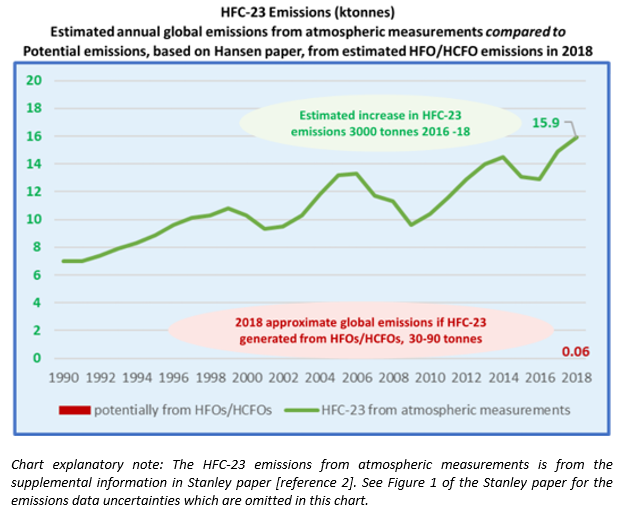NO CREDIBLE LINK BETWEEN ELEVATED ATMOSPHERIC HFC-23 LEVELS AND UPTAKE OF HFO-1234ZE
A recent paper [1] by Hansen has proposed that R-23 is formed as a minor product in yields of 11.0 ± 5.5 % from atmospheric photolysis of trifluoroacetaldehyde (CF3CHO) in the troposphere. Trifluoroacetaldehyde is an intermediate atmospheric breakdown product from HFOs and HCFOs that contain the CF3CH= group (this would exclude HFO-1234yf). The paper proposes that their study could provide an alternative explanation for the recent increase in HFC-23 emissions. It suggests that the rise in HFC-23 emissions is linked to emissions of HFO-1234ze in particular, instead of being linked to an increase in HFC-23 emissions from HCFC-22 production in China.
HFC-23 is a by-product from the production of HCFC-22. According to a 2020 paper [2], global HFC-23 emissions derived from atmospheric measurements were historically at their highest level in 2018, in contrast to the expected emissions of HFC-23 by-product, primarily from reported HCFC-22 production, that were much lower. The paper noted that in 2017 it is likely that China had not been successful in meeting its target of abating 98% of HFC-23 emissions. This conclusion is consistent with the HFC-23 emissions data for China in a 2020 TEAP Report [3], that showed only 49% of reported HFC-23 by-product production was abated (incinerated) in 2018.
The EFCTC Position Paper Refrigerant Degradation: Is HFC-23 (CF3H) formed due to the decomposition of HFOs and HCFOs in the troposphere? discusses the Hansen paper and points out that the Hansen paper reaches an entirely different conclusion to that made in an earlier published peer-reviewed paper by Chiappero [4]. The Chiappero paper studied the photolysis and quantum yields of the fluoroaldehydes CF3CHO, C2F5CHO, C3F7CHO and C4F9CHO at 254 nm and 308 nm wavelengths and states “We conclude that formation of HFCs from the tropospheric photolysis of fluoroaldehydes is of no significance.”
Could emissions of HFOs and HCFOs in the period 2016 -2018 potentially be responsible for the increase in estimated HFC-23 emissions during this period?
There are very limited published emission estimates available for HFOs (excluding HFO-1234yf) and HCFOs for the period from 2016 to 2018. A UBA report [5] published in 2021 estimates emissions for the EU-28. For 2018, UBA estimated annual EU-28 emissions of 4 tonnes of HFO-1234ze and 171 tonnes of all HFOs and HCFOs containing the CF3CH= group combined. Emissions in earlier years are expected to be lower.
To provide an approximation to global HFC-23 emissions in 2018 from HFOs/HCFOs if Hansen is considered to be correct, it is assumed that:
- Trifluoroacetaldehyde (CF3CHO) is produced in 100% yield from the photolysis of HFOs and HCFOs containing the CF3CH= group. In fact CF3CHO is formed in yields of up to 100% depending on the particular substance,
- Global emissions are 5 times the EU emissions in 2018 at 855 tonnes. The EU, due to the F-gas Regulation 517/2014, is an early adopter of HFOs and HCFOs,
- All of the emissions of relevant (i.e., CF3CH= containing) HFO and HCFO were assumed to be HFO-1234ze, and
- The potential yield of HFC-23 is 11% (in the range 5.5 -16.5%).
The resultant estimate of approximate global emissions of 855 tonnes of relevant HFOs/HCFOs in 2018 could potentially result in 30 to 90 tonnes of HFC-23. The increase in estimated global emissions of HFC-23 from existing sources in 2016 to 2018 is estimated at approximately 3000 tonnes (see Stanley paper [2] supplemental information, supplementary table 4, which also has the emissions data uncertainties). The estimated increase in global emissions of HFC-23 from existing sources for the period from 2016 to 2018 is approximately 3000 tonnes (see Stanley paper [2] supplemental information, supplementary table 4, which also has the emissions data uncertainties). This is orders of magnitude higher than the HFC-23 emissions estimated for 2018 from relevant HFOs/HCFOs based on the above assumptions.
Therefore, in conclusion, there is no credible link between elevated atmospheric HFC-23 levels and uptake of HFO-1234ze and other relevant HFOs/HCFOs.

References
[1] Jyoti S. Campbell,1 Scott H. Kable,1 Christopher S. Hansen, School of Chemistry, University of New South Wales, Sydney NSW 2052, Australia preprint Photodissociation of CF3CHO provides a new source of CHF3 (HFC-23) in the atmosphere: implications for new refrigerants. At the time of writing this, the paper is a preprint that has not been peer reviewed.
[2] K. M. Stanley, D. Say, J. Mühle, C. M. Harth, P. B. Krummel, D. Young, S. J. O’Doherty, P. K. Salameh, P. G. Simmonds, R. F. Weiss, R. G. Prinn, P. J. Fraser, M. Rigby, Increase in global emissions of HFC-23 despite near-total expected reductions, Nature Communications, 11, Article number: 397 (2020), https://doi.org/10.1038/s41467-019-13899-4
[3] May 2020 TEAP Decision XXXI/1 Replenishment Task Force Report, Table 4.3 Amounts of HCFC-22 and HFC-23 produced in various plants in China, as well as the HFC-23 reduction amounts in 2018.
[4] Malisa S. Chiappero, Fabio E. Malanca, Gustavo A. Arguello, Steven T. Wooldridge, Michael D. Hurley, James C. Ball, Timothy J. Wallington, Robert L. Waterland, and Robert C. Buck J. Phys. Chem. A 2006, 110, 11944-11953, Atmospheric Chemistry of Perfluoroaldehydes (CxF2x+1CHO) and Fluorotelomer Aldehydes (CxF2x+1CH2CHO): Quantification of the Important Role of Photolysis.
[5] UBA Final Report 73/2021 Persistent degradation products of halogenated refrigerants and blowing agents in the environment: type, environmental concentrations, and fate with particular regard to new halogenated substitutes with low global warming potential, see Table 24.